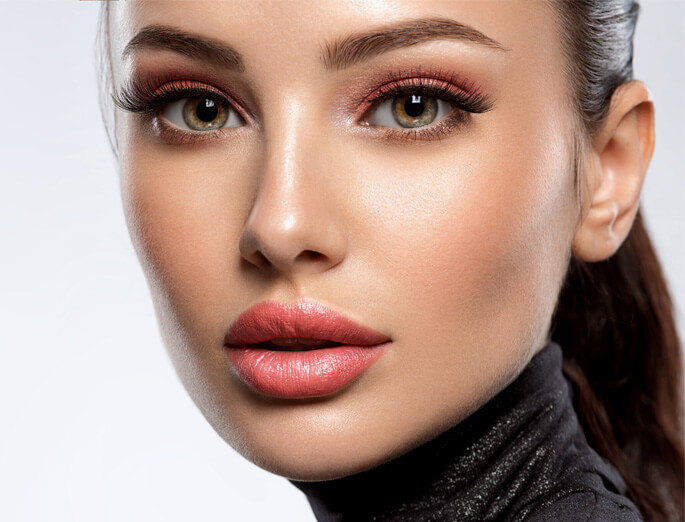Fat Transfer
What Is Fat Transfer?
Fat transfer procedures are one of the most impressive advancements in cosmetic surgery over the past decade. A large part of facial aging deals with deflation and devolumization of different parts of the face. It may be the temples, the hollows under the eyes, the cheeks, or the lines around the mouth. Dermal fillers have become a popular option to restore volume to the face and reverse these signs of aging. However, some people want more durable results that don’t require frequent and costly maintenance treatments.
Fat transfer involves performing liposuction, purifying the fat, and then carefully injecting the fat to revolumize the face. Fat transfer restores the youthful contours of the face and looks totally natural. It has durable long-lasting results because it is your own fat that is transplanted and survives in another part of your body (your face).

This 52-year-old Asian lady was bothered by excess skin covering her eyelid crease, a smaller aperture of the left eye, and dramatic hollowing along the lower lids into the cheek. She underwent a left ptosis repair, upper blepharoplasty, and liposuction with fat transfer to the lower eyelids to improve the symmetry of the eye apertures, improved definition of the upper lid creases, and a rejuvenated appearance to the lower eyelids.

This 60+ year-old lady saw a general plastic surgeon who performed fat transfer to the lower lids that resulted in bulging lumps of fat on the lower eyelids without improvement in her lower lid hollowing. She underwent a revision procedure with Dr. Lee, including a lower blepharoplasty with fat repositioning, liposuction with fat transfer to the under eye region, and laser skin resurfacing for a smoother, more youthful contour to the lower eyelids.
Why might someone want fat transfer over dermal fillers?
Patients who want fat transfer like that it is part of you and totally natural. They like that it is permanent and long-lasting.
Additional benefits of fat transfer include:
- No potential allergic or inflammatory reactions
- Does not cause eyelid swelling (this can sometimes happen with fillers under the eyes)
- Cost-effective in the long run (due to durability)
- Can be repeated for more volumization but doesn’t require maintenance treatments
- Can restore lost volume across multiple regions of the face
How Does the Procedure Work?
Fat transfer starts with removing fat from a donor area on your body. This is typically the love handle region (flanks), abdomen, or thighs. Patients like that they will help contour areas with unwanted fat. However, the goal is not high definition liposuction and body sculpting. The focus is mainly to take only the fat that is necessary for facial rejuvenation.
Once the fat is removed, it is cleaned and purified so that it has the best long-term survival. Different surgeons use different fat purification techniques, some of which are not ideal for fat survival. Patients sometimes say they had a fat transfer procedure done elsewhere that didn’t yield long-lasting results. This is normally because the fat was not harvested and purified in an ideal way.
The fat is then carefully injected in different quantities to the regions that you and Dr. Lee decide on. The fat injections are performed with small, blunt cannulas through tiny incisions that heal without a scar.
The whole procedure is done with local anesthesia and IV sedation. General anesthesia is not necessary, which makes the procedure safer and with a faster recovery time. The donor site is injected with dilute anesthetic for the liposuction (tumescent anesthesia). This ensures patients are comfortable during the procedure. Typically, the procedure takes about 2 hours, but you can return home the same day after your procedure. Someone will need to drive you home after the procedure.
How Does Dr. Lee Customize Your Fat Transfer?
Fat transfer requires careful facial analysis to determine how much and where to place the fat. The injection technique is highly customized, as the fat is injected with different techniques, at different depths, and in different regions of the face.
You can also combine fat transfer with other procedures for a more comprehensive aesthetic improvement. During your consultation, Dr. Lee works closely with you to determine which procedures will help you reach your goals and meet your expectations.

Testimonials





This 62-year-old lady underwent a quad blepharoplasty with a general plastic surgeon but was bothered by the uncorrected eyelid ptosis that made her eyes look sleepy and half closed, residual excess skin on the upper eyelids, and fat prolapse and hollowing under the eyes. She underwent a 4-lid blepharoplasty with fat repositioning, liposuction with fat transfer to the lower lids, and laser resurfacing resulting in a more alert and youthful appearance to the upper and lower eyelids.

This 60+ year-old lady with thyroid eye disease was bothered by the bulging of her eyes, lower eyelid retraction, excess skin on both upper and lower eyelids, and age-related atrophy of the temples, under eye region, and cheeks. She underwent bilateral orbital decompression surgery, eyelid retraction repair, quad blepharoplasty, and fat transfer to the temples, cheeks, and lower lids to reduce the bulging of the eyes, improve the position and symmetry of the eyelids, and restore youthful facial contours in the periocular region.
Why Do Patients Prefer an Oculofacial Plastic Surgeon for Fat Transfer?
One of the most common areas for fat transfer is in the areas around the eyes: in the hollows beneath the eyes, the cheeks, the temples, and sometimes even the hollows above the upper lids. The periocular region has the most delicate anatomy on the face, and an oculofacial plastic surgeon is highly specialized in treating this region.
It is not easy to undo fat transfer that has been done poorly, especially around the eyes. This may require surgery to reverse the unwanted results. From time to time, Dr. Lee has treated patients who have had unfavorable results with fat transfer around the eyes because the fat was not injected with proper technique. This can result in lumps, bumps, and unnatural contours.
Another potential concern with fat transfer and dermal fillers is that there have been rare reports of blindness with these procedures. As an ophthalmologist and oculoplastic surgeon, Dr. Lee understands the complex anatomy around the eyes and face. He uses specialized techniques to help prevent this rare complication.
What Is the Downtime After Fat Transfer?
After fat transfer, patients should expect some swelling, redness, and bruising for the first 2-3 weeks. The goal is to have things look overcorrected (slightly full) initially so that it looks just right by the time all the swelling has gone down. Dr. Lee expects about 60-70% of the fat injected to survive by 3-4 months. Thus, things will look a bit swollen initially, and this is intentional. After everything settles, you will see the final result and whatever fat survives will continue to survive at that point. This fat will be with you for years to come, restoring lost volume and contributing to a more youthful appearance.
Can fat transfer be repeated in the future?
It certainly can! While the fat transfer procedure has durable long-term results, it doesn’t stop the hands of time. Thus, the process of facial aging and facial volume loss continues over time. If more volume augmentation is needed or desired, an additional round of fat transfer can be done at any point in the future. With fat transfer, less is more. It is easier to do additional rounds of fat transfer, but it is not as easy to remove fat if it is overcorrected. Additional rounds of fat transfer are not considered a failure of the original procedure but part of occasional maintenance to counteract the aging process.
Can fat transfer be combined with filler?
Yes it can. Fat transfer gives a high volume and durable foundation for facial revolumization. However, once the fat settles and you have your final results, there may be some fine tuning that is required to perfect your results. Dr. Lee can layer a small amount of dermal filler on top of the foundation of fat transferred for the absolute best results
Schedule Your Consultation Today
Take the first step to restoring facial volume loss today. When you schedule your consultation with Dr. Lee, you can get started on your personalized treatment plan. Call us today to learn more about eyelid and facial fat transfer and how it can help you reach your aesthetic goals.


